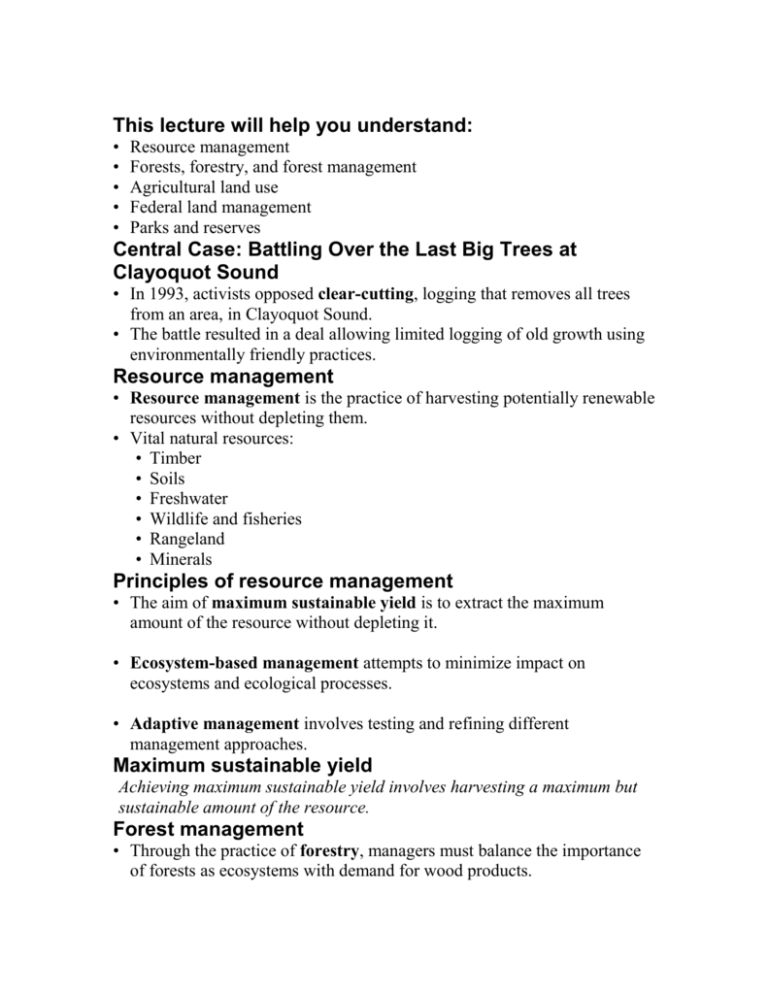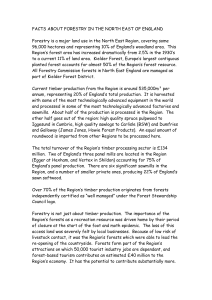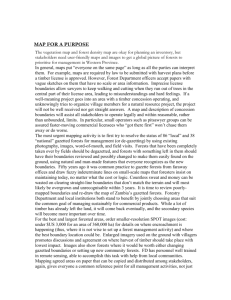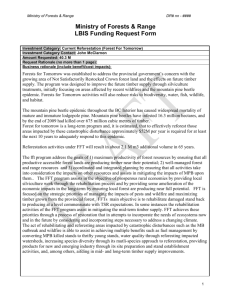Chapter12notes
advertisement

This lecture will help you understand: • • • • • Resource management Forests, forestry, and forest management Agricultural land use Federal land management Parks and reserves Central Case: Battling Over the Last Big Trees at Clayoquot Sound • In 1993, activists opposed clear-cutting, logging that removes all trees from an area, in Clayoquot Sound. • The battle resulted in a deal allowing limited logging of old growth using environmentally friendly practices. Resource management • Resource management is the practice of harvesting potentially renewable resources without depleting them. • Vital natural resources: • Timber • Soils • Freshwater • Wildlife and fisheries • Rangeland • Minerals Principles of resource management • The aim of maximum sustainable yield is to extract the maximum amount of the resource without depleting it. • Ecosystem-based management attempts to minimize impact on ecosystems and ecological processes. • Adaptive management involves testing and refining different management approaches. Maximum sustainable yield Achieving maximum sustainable yield involves harvesting a maximum but sustainable amount of the resource. Forest management • Through the practice of forestry, managers must balance the importance of forests as ecosystems with demand for wood products. • Forests are ecologically and economically valuable. Adaptive management • The Northwest Forest Plan used science extensively to guide management. Forests and deforestation Demand for wood products, and for open land for agriculture, has led to deforestation, the clearing and loss of forests, throughout the world. Africa and Latin America are losing their forests most quickly. Forests are starting to grow back in North America and Europe after centuries of deforestation. Deforestation Timber harvesting propelled the growth of the young United States. Forests were leveled first in the East, then one by one moving westward. Deforestation Over 3 centuries, Americans denuded most of their forests (green). Even in the green areas mapped above, very few large virgin trees remained; nearly all forests are second growth. Timber harvesting • Most timber harvesting in the U.S. takes place on private land, especially land owned by timber companies. • But much timber harvesting takes place on public land—national forests. • The U.S. National Forest system was established at the turn of the last century, and the Forest Service manages forests for sustainable timber yield, and, increasingly, recreation and ecosystem health. Federal lands U.S. federal agencies own a large amount of land in the western U.S., allowing resource extraction on most of it. Plantation forestry • Tree plantations feature fast-growing tree species, and are single-species monocultures. • The stands are even-aged, with all trees the same age. • Stands are cut after a certain number of years, called the rotation time, and the land is replanted. • However, some harvesting methods aim to maintain uneven-aged stands, where a mix of ages makes the stand more similar to a natural forest. Methods of logging • Clear-cutting = all trees cut, leaving only stumps; most cost-efficient, but most environmentally damaging • Seed-tree cutting = some mature trees left standing to reseed cut area • Shelterwood cutting = trees cut in multiple cuttings over multiple years, leaving some to reseed and protect against erosion • Selective logging = only some trees chosen and cut; the forest is left standing, but the biggest trees are taken, and machinery damages the forest floor Methods of logging Growth and removal of timber Forests are growing back faster than they are being cut on all types of land except timber company land. Logging subsidies Although timber harvests are falling and forests are growing on national forest lands, the Forest Service still loses an estimated $100 million of taxpayers’ money each year by accommodating private company harvests on public land: • Selling timber well below cost • Marketing and administering harvests • Building and maintaining access roads Managing forests • Forest management is guided by multiple use policy, for recreation, wildlife habitat, mineral extraction, etc. • National Forest Management Act: mandated plans for renewable resource management for all national forests. • Timber harvesting has been brought more in line with ecosystem-based management goals. • New forestry attempts to mimic natural disturbances. Management for forest fires • Fire policy has posed a particular challenge for forest management. • Fire is a natural phenomenon that can renew forests. • But decades of human fire suppression allowed lots of combustible debris to accumulate in forests. • So when fires occur, they often are damaging rather than renewing. Management for forest fires • Foresters have used prescribed or controlled burns to reduce fuel loads and restore ecosystems. • Salvage logging is the removal of dead trees, or snags, following a natural disturbance. • Economically, salvage logging may seem to make sense. • But ecologically, snags have immense value as food sources and habitat. Agricultural land use • • • • Agriculture now covers more of Earth’s surface than forests. 38% of planet’s land surface = agriculture 26% pasture/rangeland 12% cropland Intensive monocultures completely displace natural ecosystems and have a heavy impact on the land. Agriculture and wetlands Most of North America’s wetlands have been drained, filled, and converted for agricultural use. Monoculture farmland encroaches on prairie pothole wetlands in North Dakota. Rangelands • Livestock grazing: • Done badly, it can ruin soils, cause erosion and desertification. • Done responsibly, it can sustain grasslands, allowing wildlife use. • Most U.S. rangelands are federally owned and managed by the Bureau of Land Management (BLM). The West that might have been • Land use patterns in the American West came about in the headlong rush to settle and exploit its land and resources. • As a result, land suffered damage from careless grazing, farming, mining, and logging practices. • The ideas of John Wesley Powell might have prevented a great deal of harm, but were ignored… The West that might have been • Powell saw that the land was arid and vulnerable, and needed different land use policies than the moister East. • He suggested that: • Settlers be granted larger plots in the arid West than the 160-acre Homestead Act plots • Settlers be organized into cooperative irrigation districts organized by watershed—to encourage water conservation and prevent monopolies and water grabs Why create parks, reserves, and wildlands? Why set aside land and voluntarily refrain from developing and exploiting its resources? • To protect enormous, beautiful, unusual landscape features • • • • (monumentalism) For recreational use for outdoor activities For utilitarian benefits—e.g., watershed protected for drinking supply To make use of sites that have little economic value otherwise To preserve biodiversity Why create parks, reserves, and wildlands? “Monumentalism”: • 19th-century landscape painters raised great interest in the American West’s scenery—and its new national parks. • Here, Bridalveil Falls in Yosemite, by Albert Bierstadt U.S. national parks • 1872 – Yellowstone National Park becomes the world’s first national park: “a public park or pleasuring-ground for the benefit and enjoyment of the people.” • Today, the U.S. national park system includes 388 sites and receives 277 million visits each year. • It is managed by the National Park Service. U.S. national wildlife refuges • 1903 – President Theodore Roosevelt begins system of national wildlife refuges. • Today, 541 sites are managed by the Fish and Wildlife Service: “from preservation to active manipulation of habitats and populations.” • Hunting, fishing, and other recreation and allowed; policies vary from refuge to refuge. Wilderness areas • 1964 – Congress passes Wilderness Act • Wilderness areas can be designated within existing federal lands. • They are open to public recreation, but not exploitative development. Wilderness areas “To assure that an increasing population…does not occupy and modify all areas … leaving no lands designated for preservation and protection in their natural condition.” —U.S. Congress Opposition to land set-asides • Restriction of activities in wilderness areas has generated opposition from some quarters. • State governments of Western states would like to have control over more land within their borders. • Nevada = 80% of land federally owned • ID, OR, UT = 50%+ federally owned Opposition to land set-asides Wise-use movement = loose confederation of individuals who live off the land and industries that extract resources, who oppose advances of environmental advocacy, and: • Want to protect private property rights • Oppose government regulation • Want federal lands transferred to state, local, or private hands • Want more motorized vehicle recreation on public lands Land trusts Besides federal and state governments, private nonprofit groups called land trusts also set aside land for protection from development. • Local or regional organizations • 900 in U.S. own 437,000 acres and have helped preserve an additional 2.3 million acres International parks and reserves • Protected areas have been growing fast in many countries. • The world now has 38,536 protected areas, covering 9.6% of the planet’s land surface. • But many of these are “paper parks”—protected on paper, but subject to illegal exploitation because of lack of funding for enforcement. Design of protected areas How parks and reserves are designed has consequences. Recall how habitat is fragmented by development: Design of protected areas • Questions for reserve design: • What is better for biota: single large or several small (“SLOSS”)? • How important are corridors for wildlife to travel from one reserve to another? • These are key issues in conservation biology. Conclusion • Natural resources can be responsibly and sustainably managed or carelessly exploited and overharvested. • Many countries have established agencies to manage public lands. • In North America, early emphasis on resource extraction evolved into policies on sustained yield and multiple use. • Public forests today are managed for timber, recreation, wildlife habitat, and ecosystem integrity. • Public support has resulted in parks and other reserves in North America and abroad.







